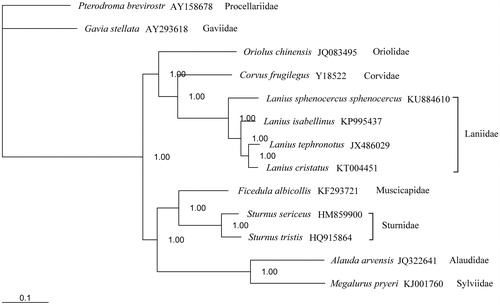Abstract
Using an Illumina platform, we sequenced the complete mitochondrial genome of Lanius sphenocercus sphenocercus to an average coverage of 1669.5×. We performed a de novo assembly using SOAPdenovo2 and obtained the total mitogenome with 16,833 bp in length. Most PCGs begin with the typical ATG start codon with the exception of COI gene, which use GTG as the initiation codon. Stop codons AGG, TAG, TAA, and AGA are present in the PCGs; exceptions are COII, COIII and ND4, which possess incomplete termination codons (T). But, the function of COII with incomplete stop codon T should be further investigated. The phylogeny revealed that genetic distance of Laniidae and Corvidae was closer than other species. Compared to other three shrike species, L. s. sphenocercus occupy a separate status in the genus Lanius.
Chinese Grey Shrike (Lanius sphenocercus) is an endemic species in Eastern Asia. It belongs to the compact group of gray shrikes and with two subspecies: nominate subspecies (Lanius sphenocercus sphenocercus) and south-west subspecies (Lanius sphenocercus giganteus) in China. At present, most studied species are the groups that inhabit Europe and North America. Data on the biology, vocalization, and behaviour of Asian species of the group are scarce (Opaev Citation2014). Especially, the limited molecular data dampen the evolution and diversity studies in genus Lanius.
A naturally dead L. s. sphenocercus was collected at Hongjian Nur (39°04'N, 109°53'E), Shaanxi, China. The specimen (Voucher number: XWBL01) was preserved in 100% ethanol and stored at −20 °C, and deposited in the animal specimens museum of Shaanxi Institute of Zoology, Xi’an, China. Genomic DNA was prepared in paired-end libraries, tagged and subjected to the high-throughput Illumina HiSeq2500 platform with 125bp paired-end strategy and yield 23,398,290 Paired-End Raw Reads with 126 bp in length. Clean reads were trimmed by removing regions with a Phred score of <10. Mapping against the complete mitogenome of Lanius isabellinus (GenBank: KP995437), high-quality reads were assembled using SOAPdenovo2 (Hahn et al. Citation2013). A total of 228,309 individual mitochondrial reads gave an average coverage of 1669.5×. Comparing with the L. isabellinus, annotations were generated in MITOchondrial genome annotation Server (MITOS) (Bernt et al. Citation2013).
The total length of L. s. sphenocercus mitogenome is 16,833 bp (GenBank: KU884610). The base composition of the entire mitogenome was 30.5% A, 25.4% T, 29.0% C and 15.1% G. There are 17 intergenic spacer regions, ranging in size from 1 to 10 bp (81 bp in total). Gene overlap involves 29 bp over 6 locations.
The typical ATG start codon is present in 12 of the 13 L. s. sphenocercus PCGs, nonstandard start codons (GTG) are found in COI. Open-reading frames of most L. s. sphenocercus genes end with AGG, TAA, AGA, or TAG, while COII, COIII and ND4 have the incomplete stop codon T. Particularly, the COII with incomplete T merely exists in Laniidae of Aves and the function is still needed to be confirmed.
The two rRNA genes, 973 bp in srRNA and 1603 bp in lrRNA, are located between tRNAPhe and tRNALeu(UUR) and separated by tRNAVal gene. All tRNA genes, ranging from 66 to 75 bp in size, can fold into a typical cloverleaf secondary structures, with exception of the tRNASer(AGY) (66 bp) which lacks the DHU arm. The control region was located between tRNAGlu and tRNAPhe with 1263 bp in length and 58.5% A + T content.
To investigate the phylogenetic position of L. s. sphenocercus, a Bayesian tree was reconstructed based on 13 mitogenomes using MrBayes ver. 3.2.2 (Ronquist et al. Citation2012) under the GTR + I + G model. Pterodroma brevirostris (GenBank: AY158678) was selected as an outgroup (Liang et al. Citation2007). The phylogram obtained from Bayesian inference (BI) strongly supported that Laniidae has the closest relationship with Corvidae. In the genus Lanius, L. s. sphenocercus is classified as Grey Shrikes which with high genetic similarities and morphological characteristics and clearly differentiated from other shrike species (Klassert et al. Citation2008; Olsson et al. Citation2010) ().
Funding information
The study was supported by the Shaanxi Natural Science Foundation, China (Grant No. 2012JQ3005), Strategic Reserve Personnel Training Project of the Shaanxi Academy of Science, China (2016).
Disclosure statement
The authors declare no competing interests.
References
- Bernt M, Donath A, Jühling F, Externbrink F, Florentz C, Fritzsch G, Pütz J, Middendorf M, Stadler PF. 2013. MITOS: improved de novo metazoan mitochondrial genome annotation. Mol Phylogenet Evol. 69:313–319.
- Hahn C, Bachmann L, Chevreux B. 2013. Reconstructing mitochondrial genomes directly from genomic next-generation sequencing reads – a baiting and iterative mapping approach. Nucleic Acids Res. 41:e129.
- Klassert TE, Hernández MA, Campos F, Infante O, Almeida T, Suárez NM, Pestano J, Hernández M. 2008. Mitochondrial DNA points to Lanius meridionalis as a polyphyletic species. Mol Phylogenet Evol. 47:1227–1231.
- Liang G, Zhang W, Lei FM, Yin ZH, Huang Y, Li TX. 2007. Comparison of Cytb and COI gene sequences from 15 species in Passeriformes. Acta Zootax Sin. 32:613–620.
- Olsson U, Alström P, Svensson L, Aliabadian M, Sundberg P. 2010. The Lanius excubitor (Aves, Passeriformes) conundrum-Taxonomic dilemma when molecular and non-molecular data tell different stories. Mol Phylogenet Evol. 55:347–357.
- Opaev AS. 2014. Behavior and vocalization of the Chinese gray shrike (Lanius sphenocerus Cabanis, 1873) at the beginning of its breeding cycle. Biol Bull. 41:879–884.
- Ronquist F, Teslenko M, van der Mark P, Ayres DL, Darling A, Höhna S, Larget B, Liu L, Suchard MA, Huelsenbeck JP. 2012. MrBayes 3.2: efficient Bayesian phylogenetic inference and model choice across a large model space. Syst Biol. 61:539–542.

